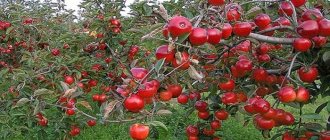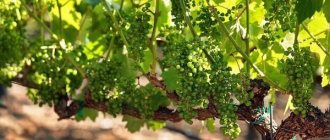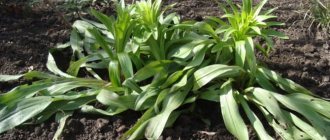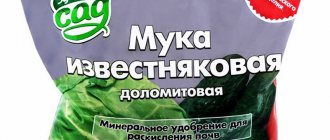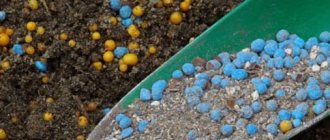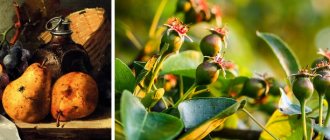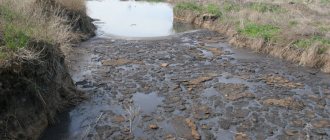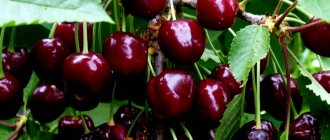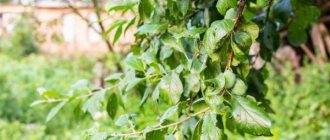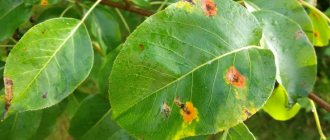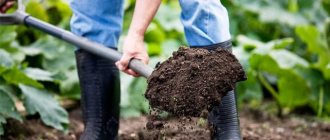What fertilizers should I apply to the pear?
You need to feed the plants! Only thanks to a balanced diet, foliar treatments, and root feeding can one expect a rich harvest and eliminate the rhythmicity (inconsistency) of fruiting of pear and other fruit trees. Mineral and organic components provide compact young growth as a guarantee of a future harvest.
Mineral
The pear's need for minerals is distributed over time periods:
- 1st half of the growing season (spring) - nitrogen fertilizers to activate growth processes; for example, ammonium nitrate (nitrogen more than 30%) - 20-30 g per 1 sq. m of trunk circle;
- starting from the end of June and until the fall, phosphorus and potassium (superphosphate, potassium salt, etc.) are added.
The most common and affordable mineral fertilizers for pears are used:
- ammophoska;
- nitroammophoska;
- superphosphate;
- ammonium nitrate;
- potassium nitrate.
Ready-made mixtures that meet the needs of fruit plants are easy to use
- Biocomplex BTU-r , 15 ml – universal microbiological fertilizer for vegetable and garden crops. Contains macro- and microelements, phytohormones and vitamins. Used when planting seedlings and routine fertilizing. Provides survival rate, stress resistance during transplantation, protects the soil from phytopathogens.
- Ecoplant , 5 kg – natural fertilizer, does not contain chlorine and nitrogen. The active composition contains potassium (up to 40%), phosphorus (5-7%), magnesium (10-12%), calcium (17%), sulfur (more than 10%). It is used as a pre-planting fertilizer in spring and autumn to loosen the soil in the root zone of fruit trees.
- Rosafert (Rosafert) , 1 kg – NPK complex of essential minerals (15:15:15) for fruit and berry plants. Intended purpose: fertilizing garden trees in spring and summer. The granules do not contain chlorine or heavy metal impurities. Feature - a balanced composition increases the size of the fruit, increases productivity by 35-40%, sulfur and calcium protects against rust, fungal infections and viruses.
Organic
Supporters of eco-farming fertilize the garden with organic matter :
- bird droppings;
- cow or horse manure;
- humus;
- wood ash;
- compost.
If there is no mullein or poultry droppings on the farm, then in garden centers and stores you can buy ready-made concentrated organic mixtures:
- Kurnik , 4 kg – organic natural fertilizer in granules. The active ingredient is chicken manure. A balanced composition increases soil fertility, affects the moisture capacity and air permeability of the soil. Apply as a basic top dressing in spring or autumn. When planting seedlings, use it as a nutrient layer (0.5 kg at the bottom of the planting hole).
- Bioterra , 11 kg – universal humified compost. Release form: powder, soluble in water. Natural raw materials – ostrich, horse, cow manure, pig manure bedding, organic waste. Apply throughout the season.
- AgriFlex Amino (Agriflex Amino) , Organic Standard, 1 kg – stimulant, anti-stress agent on a natural basis. Containing L-amino acids – phytoenergetics, they structure the soil, affect protein biosynthesis, and stimulate growth processes. The powder preparation is completely soluble in water. It is used in the spring when planting seedlings through drip irrigation; in the summer it is used as a foliar fertilizer.
Submission rules
Before using the drug, it is important to read the information sheet carefully. The instructions provide detailed composition, dosage, fertilizer application mode, and compatibility with other fertilizers.
Attention! Experimenting with tank mixtures and determining the dose of fertilizers by eye is strictly prohibited.
An overdose can burn the root system and cause negative side effects:
- illness;
- undesirable growth of green mass;
- fruit cracking;
- accumulation of nitrates and pesticides in fruits.
How to make spring feeding
It is carried out in 4 main ways:
- adding an aqueous solution to the soil (it is advisable to pour it into small holes made with a crowbar);
- granular mineral fertilizers are laid out on the surface, followed by moving to a depth of 10 centimeters and digging up the soil;
- liquid (applied by root or foliar method);
- spraying on the leaves (this is a good way to treat the tree to replenish the nutrient deficiency).
An important nuance is that all fertilizers containing nitrogen must be prepared immediately before use. Do not use a mixture that has been prepared more than 12 hours in advance.
Scheme for applying basic fertilizers:
| View | Method of use | Recommended Doses |
| Ammonium nitrate | Apply only in the form of a solution or for subsequent digging. Pre-moisten the soil, then water it, after which the liquid quickly penetrates to the roots. | Maximum 30 grams per circle of root soil. |
| Urea | Root application is used using grooves along the perimeter. | From 80 to 120 grams of fertilizer per tree. |
| Organic mixture (compost combined with bird droppings) | Green is prepared from 2 buckets of dandelion leaves or other weeds and 1 kilogram of droppings, the mixture is mixed with 2 buckets of water. | Approximately 25 liters for one tree. |
| Nitroammofoska | Replenishes reserves of nitrogen, phosphorus, sulfur, potassium. Watering the soil with a fertilizer solution. It is not recommended to combine with organic fertilizers (manure, compost, humus, bird droppings) | Up to 30 liters of solution for one tree. |
| Chicken droppings | For root feeding by watering the soil. Undiluted litter should not be used, as there is a risk of burning the roots. When purchasing, you should prefer dry fertilizer. | 600 grams per 12 liters of water, leave for 7 days. |
| Concentrated solution of manure (mullein) | Watering the soil around the roots, or into previously dug holes. | 1 kilogram of mullein per 10 liters of water, leave for 7 days. |
| Wood ash (solution) | Spraying the leaves is done before or after the flowering period. | 1 kilogram per 10 liters of water, stir thoroughly until smooth. |
Before feeding the pear, it is important to check the weather forecast. When it rains, it is better to apply almost any fertilizer followed by digging up the soil. In dry weather, it is rational to use an aqueous solution.
The age of the tree matters:
| Age | Amount of feeding | |||
| Organic | Nitrogenous | Phosphorus | Potash | |
| Seedling (before the beginning of the fruiting period) | No need | up to 6 grams | No need | No need |
| Young tree (does not bear fruit) | up to 1 kilogram | 9 grams | 6 grams | 9 grams |
| Mature (active fruiting) | up to 1.5 kilograms | 12 grams | 9 grams | 12 grams |
| Mature (at maximum yield) | up to 2 kilograms | 15 grams | 12 grams | 15 grams |
It is difficult to obtain excess nutrients if you follow the instructions.
Fertilizing schedule
The exact time of fertilization depends on climatic conditions, the type and condition of the soil, and the growing season of pear development.
Feeding pears in spring: March-April
As soon as the snow melts, before buds appear, pear trees need care:
- the tree trunk circle is loosened shallowly, 7-10 cm;
- organic mixtures and complex mineral fertilizers are poured on top of the loose soil;
- Be sure to water the nutrient mixture (mineral granules dissolve only in water).
In early spring, before sap flow begins, it is important to carry out disinfection procedures . Until the pest larvae become active, the trunks and branches are thoroughly treated with a concentrated solution of copper or iron sulfate (200-300 g per 10-12 liters of water). You can spray until the leaves appear.
Common Mistakes
The worst mistake you can make is overfertilizing. An overdose is just as dangerous as a lack of feeding. When there is too much nitrogen, the tree grows too much leaf mass. This deteriorates the quality of young shoots, and flower buds are poorly formed.
If there is an excess of soil fertilizing, the roots burn, leading to the death of the tree. With an overdose of magnesium and potassium, the fruits become small and deformed, and the color of the leaves changes. It is almost impossible to restore the tree to its previous state; the pears have to be uprooted. To avoid such trouble, it is important:
- follow the recommended dosage according to the instructions;
- It is undesirable to mix several types of fertilizers (mineral and organic);
- follow the fertilizing schedule (if any fertilizer is not applied in the spring, the next fertilizing should be done only the next year).
It is optimal to use a lower dosage to start with. Excessive accumulation in the soil is also bad for foliar feeding.
Feeding pears with folk remedies
A pear, plum or apple tree ripens, the fruits are filled with sugars and vitamins. It is important to preserve the harvest at the finish line. To ensure that all efforts to provide nutrition and control pests (flower beetle, codling moth) are not in vain, it is necessary to support the phytoimmunity of fruit trees.
To stimulate the immune system, so that the tree has enough strength to hold the harvest and bring it to full maturity, infusions of baker's yeast .
Safe yeast feeding on the leaves does not leave stains on the fruit (unlike irrigation with mineral fertilizers), is completely absorbed and does not affect the taste. In organic form, the plant receives a complex of nitrogen, phosphorus, potassium, vitamins and succinic acid.
Homemade pear fertilizers and application techniques
Yeast tincture for preserving and increasing the quality of the harvest of pears and apples:
- Dilute 70 g of dry yeast or 100 g of raw yeast in 1 liter of warm (not hot) water;
- stirring, dilute with 9 liters of water;
- generously treat trees leaf by leaf;
- consumption per adult tree – 5-7 liters of ready-made solution;
- treatment mode - every 7-10 days, if the ovary falls off;
- Preventive spraying is carried out once every 12-14 days.
Important: 2 weeks before harvesting pears, apples, plums, health spraying with yeast tincture is stopped so as not to attract flies, wasps and bees to the fruits.
Preparing pears for winter
The main amount of fertilizers (organic and mineral) is needed by the garden in the fall. When preparing a pear for the winter, any organic matter :
- compost;
- rotted manure;
- diluted chicken manure.
Consumption rate – 1-1.5 buckets of dry fertilizer or solution for each pear or apple tree.
Fertilizers are embedded in the soil to a shallow depth, 20 cm. In winter, together with snow, nutrients penetrate deep into the fertile layer, supporting the root system.
How to properly feed a pear tree in spring?
We recommend reading our other articles
- How to treat mastitis in cows
- Aphelandra flower
- The benefits and harms of peach
- How to properly milk a goat after the first lambing
Often gardeners, having studied the question of how to feed a pear in the spring, forget about the technology of the process itself. There are simple rules, non-compliance with which can lead to low yield, sickness of the tree or a number of other problems.
- The first thing that is important to follow is the dosage.
It is better to take a lower concentration if you are not sure, than a higher one, since the abundance of any substances in the soil is detrimental to plants. The first thing that is important to follow is the dosage. - You should not use several types of nutrients at once. We are talking about the same overdose. When a gardener mixes chicken manure with urea, he, in fact, introduces a “horse” dose of nitrogen under the tree, because it is this mineral that is found in high concentrations in both of these fertilizers. As a result, the roots get burned, which cannot be cured. So it’s worth researching fertilizers before mixing.
- It is necessary to feed the pear tree in the spring with certain substances on time. If the gardener did not have time to add urea before flowering began, then he should not do it at all this year. You can use fertilizer for the next stage of tree development, but do not catch up. It will be possible to practice next year.
The best time to plant a pear
The leaves begin to turn yellow - it’s time to plant fruit trees with an open root system.
Important: autumn is the best time to plant all fruit trees (pear, apple, plum, cherry plum).
Rules for planting pear seedlings and other fruit trees:
- yellowed leaves are removed from the seedling;
- prepare planting holes in advance, 3-4 weeks in advance (moisten, fertilize);
- The basic rule is that trees are planted 25-30 days before the first frost.
Pears, like all fruit plants, cannot fully develop in infertile soil. The soil composition is constantly being formed.
When planting a pear seedling in the fall you need:
- plow and dig up the area deeply, with a shovel full;
- remove all weeds with roots;
- add humus, compost or rotted manure, approximately 2-3 kg, ash and granulated nitrogen fertilizer (for example, 2 tablespoons of nitrophoska per 1 sq. m);
- dig a hole 50-60 cm deep and up to 80 cm in diameter;
- a drainage layer (pebbles, expanded clay) is laid at the bottom of the pit;
- a layer of a mixture of peat, river sand and humus is scattered onto the drainage (in a ratio of 1:1:1);
- moisten the pit well (spill 10-12 liters of water).
In the future, humus, compost, and mineral complexes are introduced into the tree trunk space every year in the fall.
General advice for gardeners
Experienced gardeners recommend:
- During dry periods, fruit trees require replenishment of natural moisture losses. Apply regular watering and sprinkling of the crown . An important point is that excess moisture on the surface of the leaf plate causes an outbreak of fungal diseases. Sprinkling is carried out only in the early morning hours, so that the water evaporates during the day and the leaves dry out.
- Already at the end of summer, sanitized . Remove diseased, dried, broken branches.
- Decaying, mummified fruits are removed from the tree immediately . The affected fetus is the source and carrier of the infection. The fallen ovary and leaves are also collected and removed.
- At the beginning of autumn, experienced gardeners harvest berries - viburnum, rowan, hawthorn, and ornamental varieties of apple trees. In winter, dried berries hung on trees in the garden attract birds. Wintering nurse birds destroy pests.
How to determine which microelements are missing?
Upon careful examination of the plant based on its external signs, an experienced gardener will determine which microelements are missing:
- Nitrogen. If it is deficient, the leaves develop poorly and have a pale appearance.
- Phosphorus. If there is a shortage of it, the flowering process is absent or in insufficient quantities.
- Potassium. With a lack of potassium, the leaves curl and dry out.
- Calcium. With a lack of calcium, spots appear on the leaves.
